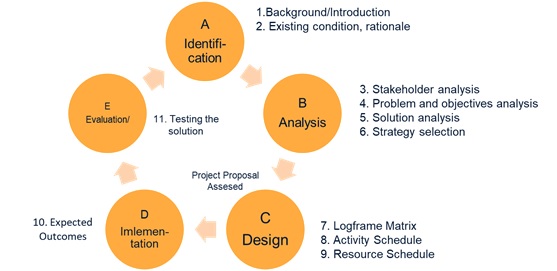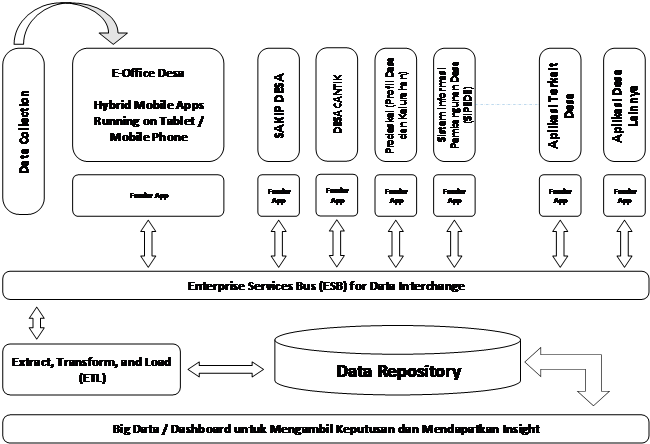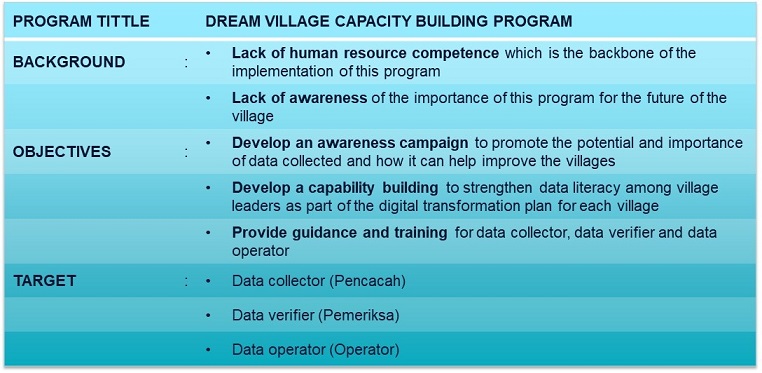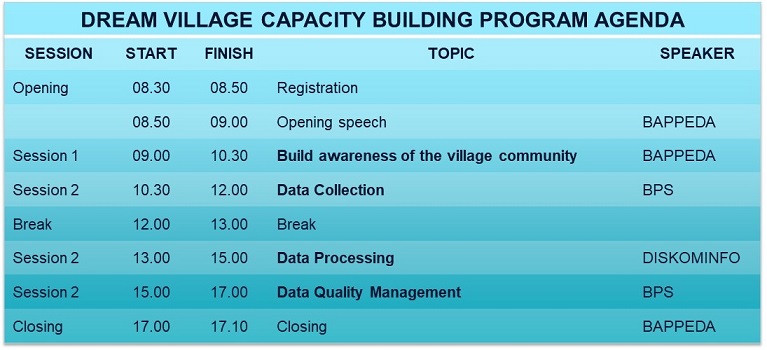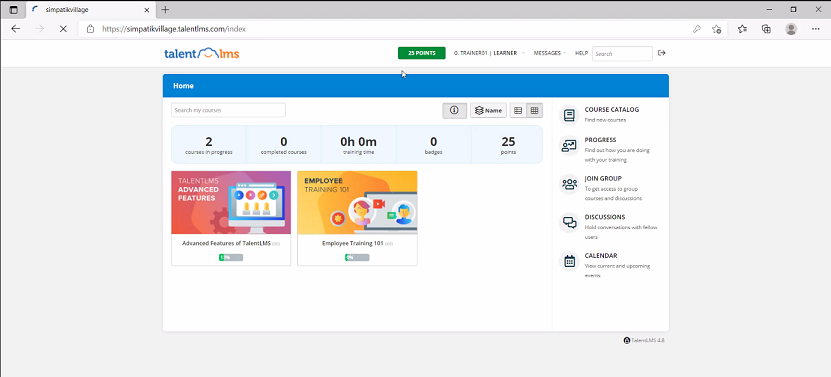Difference between revisions of "HDX Team 1 - Connected Dream Village"
imported>Nasirbwhite |
imported>Nasirbwhite |
||
| Line 207: | Line 207: | ||
=== Prodeskel Scripts === | === Prodeskel Scripts === | ||
'''[https://drive.google.com/drive/u/1/folders/175SNAsKRuxDYOuEFHmR_jJ_PNyx7DPZ_ Prodeskel Scripts]''' | |||
Revision as of 17:50, 21 August 2021
HDX Team 1 - Connected Dream Village Improving an Inspirational Super Application For The Village Governance Management of Sumedang Regency
Introduction
Project compilation methodology for connected dream village project using Project Cycle Management (PCM). Programme/Project Cycle Management is a term used to describe the management activities and decision-making procedures used during the life-cycle of a programme/project (including key tasks, roles and responsibilities, key documents and decision options). PCM helps to ensure that:
- projects are supportive of overarching policy objectives of the EC and of development partners;
- projects are relevant to an agreed strategy and to the real problems of target groups/beneficiaries;
- projects are feasible, meaning that objectives can be realistically achieved within the constraints of the operating environment and capabilities of the implementing agencies; and
- benefits generated by projects are likely to be sustainable.
To support the achievement of these aims, PCM:
- requires the active participation of key stakeholders and aims to promote local ownership;
- uses the Logical Framework Approach (as well as other tools) to support a number of key assessments/analyses (including stakeholders, problems, objectives and strategies);
- incorporates key quality assessment criteria into each stage of the project cycle;and
- requires the production of good-quality key document(s) in each phase (withcommonly understood concepts and definitions), to support well-informed decision-making.
Project Cycle Management (PCM)
Identification
Background
Digital Platform Village is a concept of development for village empowerment through information technology. It is hoped that with the availability of an information technology infrastructure, the village community would be able to access information as done so in the city. In addition, through the use of digital technology, important information can be better managed with increased data accuracy, thus improving the economic potential for growth in the village through the use of data. The issue of a digital divide noted between the central government and local government with regards to data transformation needs to be noted in view of ensuring a supportive governmental system for overall prosperity. Hence, it is important to review the need to establish a knowledge based information village system for long-term human achievement.
Sumedang Regency has 270 villages and one regency in west java. Sumedang has a rich source of natural resources, including tourism, traditional cuisines, traditional craft, agriculture, farm and forestry. Sumedang village had been established as a digital village since year 2019 and received an achievement award from the central government, Ministry of villages, disadvantaged Regions and Transmigration as the pioneer of Village Government Agency Performance Accountability System for supporting Village SDGs.
In the establishment of a digital village, 30 villages have used the digital platform E-Office through the government electronic system. Currently based on its usage, the Sumedang village encounters obstacles related to the development of its digital programme, utilisation of the digital platform and lack of IT talent and resource. E-Office system which is used by Sumedang regency needs to be developed further for better utilisation to serve the Sumedang government and cater to the civil servants and administration of the village. Through the E-Office System, better data integration and synergy needs to be developed to meet the needs of the stakeholders and the central government.
Based on the existing condition, the HDX team of Dream Village has developed the scope of problems in order to find a solution to support the Sumedang Government in developing a digital village. The scope problems are formulated as follows :
- Lack of human resources competence which has backboneof the implementation of E-Office Desa Apps
- Lack of awareness of the importance of E-Office programe to improve village income in the future.
- E-Office system which is used incomplete and need to develop in the future
Existing Condition
- To develop an enterprise service bus for data interchange using feeder application, so that the civil services of Sumedang regency can use it as an integrated data reference.
- To design the Term of Reference for a capacity building programe, through an LMS mock up plan.
Problem and Objectives Analysis
Stakeholder Analysis
- Stakeholder Pitching : Local Government Sumedang, Kemendagri, BPS
- Stakeholder : Policy local government
- Formal : Regulation, Budgeting, Human Resource
- Function : Managing Village Governance, Operation and Maintenance for digital transformation in local government, Online training System For Data Collection
- Bappeda : Institution for allocation budget and resource for implement
- Sekda and Dinas Kominfo : to Improve the system and capacity building
Problem Analysis
- E-Office Desa Can Not Supply Datas For External Beneficiaries Apps
- Lack Of Human Resources Competence For Data Supplying
Solution Analysis / Analysis of Objectives
- Discuss Solution : Refine Stakeholder needs, Explore feasible concept : Feeder Application, Enterprise service Bus (ESB)Data interexchange
Strategy Selection
- Using Logical Framework Approach
- Develop Enterprise Service Bus (ESB) For Data Interchange Using Feeder Apps
- Create Program Of Data Supplier Capacity Building Using LMS
- Develop an awareness campaign to promote the potential and importance of data collected and how it can help improve the villages
- Develop a capability building to strengthen data literacy among village leaders as part of the digital transformation plan for each village
- Provide guidance and training for data collector, data verifier and data operator
- Build Awareness Of The Village Community
- To increase the awareness of communities on the importance of data literacy and how it can help improve villages welfare through appropriate decision-making and policies
Project Outcome and Output
Logical framework Matrix
Logical Framework Approach is a good analytical tool in the assessment, follow-up and evaluation of a project using a logical approach. The logical approach in this case is to build a hierarchy of logical frameworks that are oriented towards project goals to help clarify project or program objectives, identify causative relationships between inputs, processes or activities, outputs, outcomes and impacts. In table below showing the logical framework matrix of this project.
| Logic Frame | ||||||||||||||||
|---|---|---|---|---|---|---|---|---|---|---|---|---|---|---|---|---|
| Problem Statement: | ||||||||||||||||
| ||||||||||||||||
| GOAL: | ||||||||||||||||
| ||||||||||||||||
|
|
| ||||||||||||||
Timeline
Timeline is a written document that contains information about the plan of work or project implementation schedule, when each stage of work must begin and be completed and it also contains information about the stages of work sequentially. The timeline is an important document that guides the team’s work steps so that the project can be managed and monitored properly. In this project, we divide the work plan into 3 major stages, namely: identification stage, problem and objective analysis stage, and lastly project outcomes and output stage. The details of this project plan and timeline can be seen in the table below.
Resources
As an effort to overcome the problems that occur in this project and meet the program targets, there are resources needed, namely:
- Human resources. Human resources involved in the success of this project must have adequate competencies such as qualified data collector, data verifier and data operator, qualified planner (Bappeda as the owner of this project) and qualified programmer and developer.
- Logistic. Intended logistic means village funs that allocated to employ qualified data operator.
- Skill. In order to have a competent human resource requires qualified skills. Through capacity building program for data collector, data verifier and data operator, it is expected to produce skillful human resources.
- Knowledge. Knowledge that is important to understand in this project is to build awareness of the importance of the success of this project for improving the village quality of life.
- Tool. The tools needed to support the success of this project are regulations and implementation of reward and punishment system
Project Implementation and Testing
- Beneficiaries data bridging through feeder application
- Develop enterprise service bus (ESB) for data interchange using feeder application
- Enterprise Service Bus
- Enterprise Service Bus (ESB) is a centralized software component that integrates various applications and systems. ESB performs data transformation, message routing between applications, and translates various communication protocols owned by each system. ESB can be implemented using WSO2, an open-source software available in the market.
- Feeder Application
- Feeder App is an application built to bridge data collection from each village application. The data taken from each village application will be sent to the Enterprise Service Bus.
- File:FeederApp.png
- Data page on Prodeskel application
- File:FeederApp2.png
- Data feeder application and Prodeskel have been synchronized
- Create capacity building program
- There are 3 objectives of creating capacity building programe:
- Develop an awareness campaign to promote the potential and importance of data collected and how it can help improve the villages
- Develop a capacity building to strengthen data literacy among village leaders as part of the digital transformation plan for each village
- Provide guidance and training for data collector, data verifier and data operator.
- We proposed that the program is delivered using LMS (Learning Management System). LMS has many functions and advantages including:
- Compiling syllabus of program
- Managing learning material
- Manage grade, attendance recapitulation and display grade transcripts
- Discussion and quiz
- More efficient learning time
- Cost efficiency compare to offline program
- Easy to implement technologies such as animation, video and text
- Encourage independent learning
- Well documented learning content
- We have held socialization and training for trainer on the use of LMS (Simpatik Village LMS) to stakeholders in Sumedang Regency and received very good feedback. After the socialization and training, Department of Communication and Information Technology Sumedang Regency (Diskominfo Sumedang) has carried out further exploration which confirms that the LMS solution we offer is very good, complete, simple user interface and willing to be used in Sumedang Regency.
- File:Simpatik lms.png
- LMS Socialization and Training for Traineer Documentation 1
- File:Simpatik lms2.png
- LMS Socialization and Training for Traineer Documentation 2
Project Outcome
- Feeder application mock up
- In overcoming issues related to the Village e-office application that has not been able to communicate data with other applications outside the system created by the Sumedang’s Regency Government such as applications from the Ministry, a Feeder App is made that can communicate data between the village e-office application and applications from the ministry or other.
- Feeder App is an application for bridging data from one system to another. Feeder App system can use API or Custom. In simple terms, the Feeder App works by taking data from the Village e-office system and then sending the data to other systems, either from ministries or agencies or other external systems. With the Feeder App, it is possible for village operators not to double input and prevent data redundancy, so it is very helpful to realize One Data in Sumedang’s Regency with Ministry or Agency data.
- File:Feederdashboard.png
- Feeder app dashboard 1
- File:Feederdashboard2.png
- Feeder app dashboard 2
- Term of reference of capacity building program
- Capacity building program material:
- Build awareness of the village community
- Objective: to to increase the awareness of communities on the importance of data literacy and how it can help improve villages welfare through appropriate decision-making and policies
- Data collection
- Objective: to produce data standardisation and harmonisation by ensuring minimal levels of quality are met with all data sets and that multiple data sets which need to be integrated have met the minimum quality requirements and standards
- Data processing
- Objective: to ensure all data that has been collected can be processed correctly through the available digital portal
- Data quality management
- Objective: to ensure alignment of all datasets for completeness, accuracy, reliability, validity, timeliness, integrity, confidentiality and ethics when handling data
- Learning management system (LMS) mock up
- Learning Management System (LMS) is a system that handles online learning. In increasing the capacity of operators or village staff in Sumedang’s Regency, we introduce and conduct training to stakeholders in Sumedang to use LMS in the hope that later it can be used to conduct training for human resources in the village.
- The LMS that we introduce are LMS products from: Talent LMS which can easily organize and manage an online learning. In the training, we introduced how to register in talent LMS, how to make a lesson, create a syllabus, add users, make quizzes, enter materials and others.
== Conclusion and Recommendation
- Develop enterprise service bus (ESB) for data interchange using feeder application Can Improve data usage for better decision making
- Create program of data supplier capacity building for Knowledge improvement, can Using LMS (Learning Management System), likes : https://www.talentlms.com/ (base on cloud), user friendly.
Summary and Aknowlegment
Thank you to all stakeholders involved in CPW including: Stakeholders from Sumedang Regency, Regional Secretary, Bappeda, Diskominfo, BPS, Village Management. Thank you for being willing to provide information and be involved in stakeholder pitching and provide reviews and input. Last but not least, thank you to Tsinghua University, UID Team, all the resource persons who have given us the opportunity to study together in this very valuable course. Last but not least thanks also to all Dream Team 1 and all participants who have studied and interacted together during the course to improve their knowledge, knowledge and skills. I love you all and see you at the top.
Appendixes
Team Members
- Aris Winarna
- Anang Latif
- Anastasya Yolanda
- Danny Januar Ismawan
- Florence Francis
- I Gusti Ayu Laxmy Saraswaty
- I Kadek Agus Arya Wibawa
- Ketut Agus Indra Diatmika
- Nasir Ahmad
- Tri Haryanto
Process Documentations
{{#ev:youtube|https://www.youtube.com/watch?v=K5ArdCjOKBs%7C%7C%7C%7C%7Cstart=100&end=103}}
